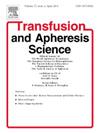Genetic determinants of plasma testosterone in male blood donors are associated with altered red blood cell characteristics and survival in cold storage and after transfusion
IF 1.4
4区 医学
Q4 HEMATOLOGY
引用次数: 0
Abstract
Genetic mutations in genes regulating plasma testosterone in men may interfere with effective erythropoiesis, and may result in red blood cell (RBC) dysfunction and hemolysis. The aim of this study was to identify genetic polymorphisms in male donors that regulate plasma testosterone and impact RBC survival in cold storage and after transfusion. We evaluated nine single nucleotide polymorphisms (SNPs) previously reported to be associated with circulating testosterone in male plasma. These SNPs were linked with donor-component-recipient databases (NIH REDS program) to determine SNP associations with donor RBC hematological indices, osmotic and oxidative hemolysis, and RBC transfusion effectiveness defined as adjusted hemoglobin increments (delta hemoglobin, ΔHb) following a single RBC unit transfusion. Four of the nine testosterone SNPs were located on the X chromosome, of which two (rs7057002, rs73629199) were significantly associated with reduced hemoglobin increments (0.2 and 0.3 g/dL, respectively) compared with reference alleles in transfused recipients. Seven of the nine testosterone SNPs were associated with significant changes in RBC susceptibility to osmotic hemolysis including a missense mutation in the major plasma carrier of testosterone (SHBG, rs6259), and four SNPs with changes in oxidative hemolysis. Four SNPs were associated with decreased RBC count, hemoglobin, and hematocrit. Ancestry/ethnicity-specific (African and Hispanic) associations were observed between two SNPs (rs7057002, rs7879462) and oxidative hemolysis. Genetic determinants of plasma testosterone in male donors significantly impact the quality and transfusion effectiveness of cold stored RBCs. Testosterone SNPs associated with decreased RBC transfusion effectiveness may have clinical implications and warrant further revaluation.
男性献血者血浆睾酮的遗传决定因素与红细胞特性的改变以及冷藏和输血后的存活率有关。
男性血浆睾酮调节基因的基因突变可能会干扰有效的红细胞生成,并可能导致红细胞(RBC)功能障碍和溶血。本研究旨在确定男性捐献者中调节血浆睾酮并影响红细胞冷藏存活率和输血后存活率的基因多态性。我们评估了之前报道的与男性血浆中循环睾酮相关的九个单核苷酸多态性(SNPs)。这些 SNP 与供体-成分-受体数据库(美国国立卫生研究院 REDS 计划)相连接,以确定 SNP 与供体 RBC 血液指数、渗透性溶血和氧化性溶血以及 RBC 输血效果(定义为单次 RBC 单位输血后的调整血红蛋白增量(δ血红蛋白,ΔHb))的关系。九个睾酮 SNPs 中有四个位于 X 染色体上,其中两个(rs7057002 和 rs73629199)与输血受体的参考等位基因相比,与血红蛋白增量的降低(分别为 0.2 和 0.3 g/dL)显著相关。在 9 个睾酮 SNPs 中,有 7 个与红细胞对渗透性溶血敏感性的显著变化有关,包括睾酮的主要血浆载体(SHBG,rs6259)中的一个错义突变,以及与氧化性溶血变化有关的 4 个 SNPs。四个 SNP 与红细胞计数、血红蛋白和血细胞比容下降有关。在两个 SNPs(rs7057002、rs7879462)与氧化溶血之间观察到了祖先/种族特异性(非洲裔和西班牙裔)关联。男性捐献者血浆睾酮的遗传决定因素对冷藏红细胞的质量和输血效果有显著影响。与红细胞输血效果下降相关的睾酮 SNPs 可能会对临床产生影响,值得进一步评估。
本文章由计算机程序翻译,如有差异,请以英文原文为准。
求助全文
约1分钟内获得全文
求助全文
来源期刊
CiteScore
3.60
自引率
5.30%
发文量
181
审稿时长
42 days
期刊介绍:
Transfusion and Apheresis Science brings comprehensive and up-to-date information to physicians and health care professionals involved in the rapidly changing fields of transfusion medicine, hemostasis and apheresis. The journal presents original articles relating to scientific and clinical studies in the areas of immunohematology, transfusion practice, bleeding and thrombotic disorders and both therapeutic and donor apheresis including hematopoietic stem cells. Topics covered include the collection and processing of blood, compatibility testing and guidelines for the use of blood products, as well as screening for and transmission of blood-borne diseases. All areas of apheresis - therapeutic and collection - are also addressed. We would like to specifically encourage allied health professionals in this area to submit manuscripts that relate to improved patient and donor care, technical aspects and educational issues.
Transfusion and Apheresis Science features a "Theme" section which includes, in each issue, a group of papers designed to review a specific topic of current importance in transfusion and hemostasis for the discussion of topical issues specific to apheresis and focuses on the operators'' viewpoint. Another section is "What''s Happening" which provides informal reporting of activities in the field. In addition, brief case reports and Letters to the Editor, as well as reviews of meetings and events of general interest, and a listing of recent patents make the journal a complete source of information for practitioners of transfusion, hemostasis and apheresis science. Immediate dissemination of important information is ensured by the commitment of Transfusion and Apheresis Science to rapid publication of both symposia and submitted papers.

 求助内容:
求助内容: 应助结果提醒方式:
应助结果提醒方式:


